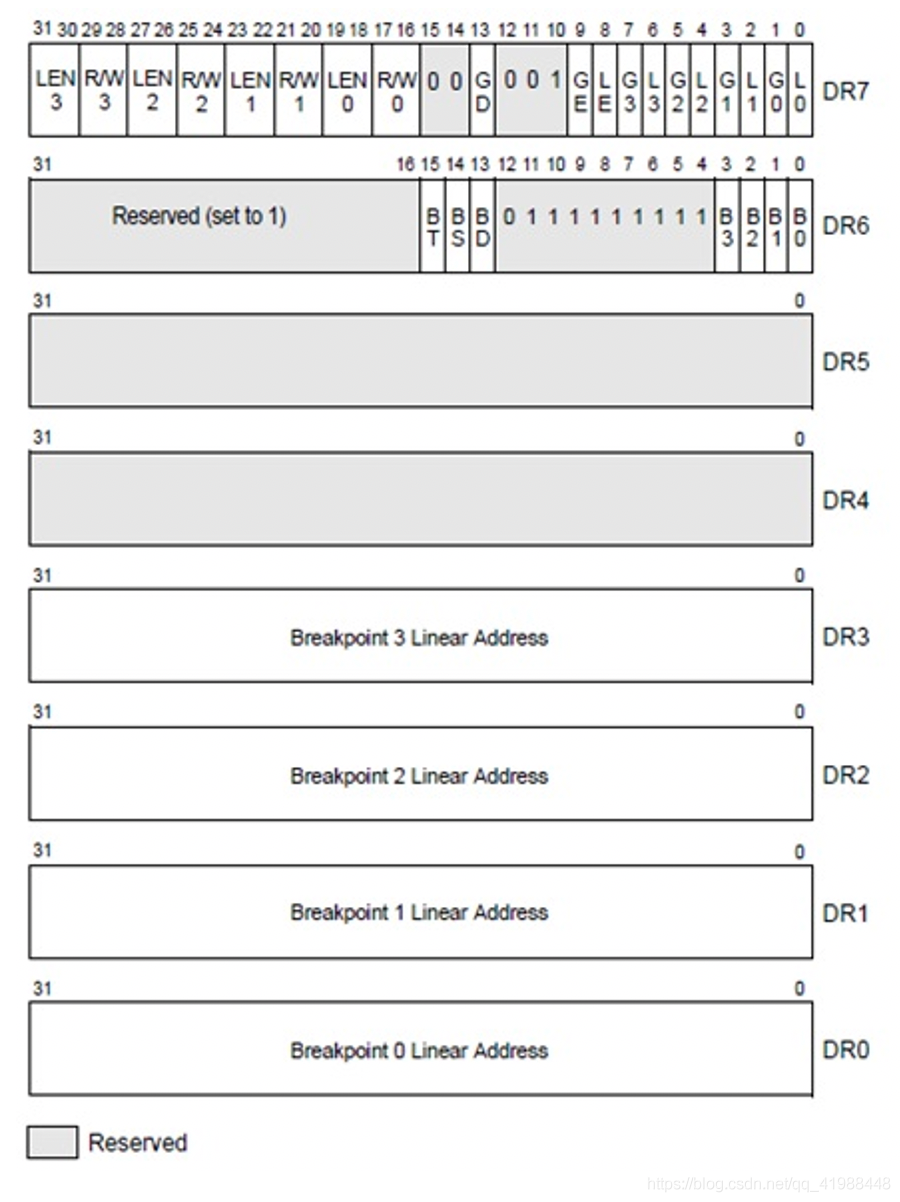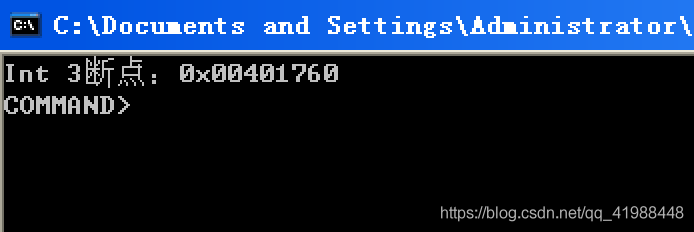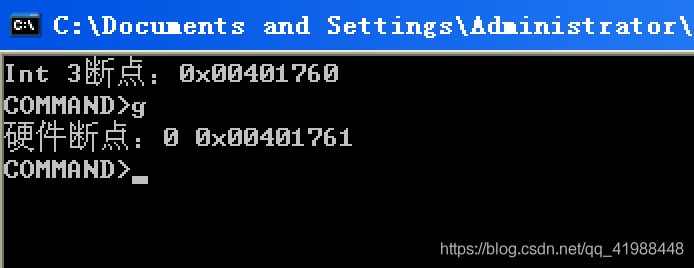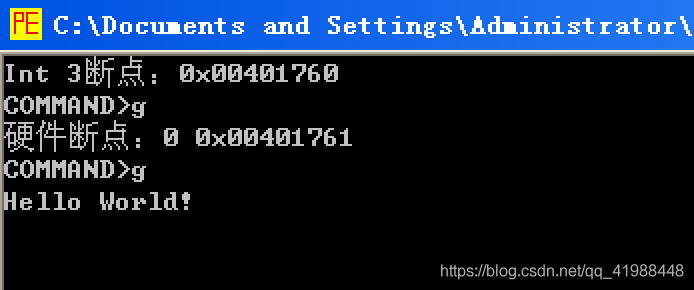hardware breakpoint
Description:
- Unlike software breakpoints and memory breakpoints, hardware breakpoints do not depend on the debugged program, but on the debug register in the CPU.
- There are 7 debug registers, Dr0~Dr7 respectively.
- The user can set up to 4 hardware breakpoints because only Dr0~Dr3 are used to store linear addresses.
- Among them, Dr4 and Dr5 are reserved.

Think: if you write a linear address in the Dr0 register, will all threads be affected?
Answer: No, each thread has an independent register. When switching threads, the value of the register will also be switched.
Set hardware breakpoints
1) Dr0~Dr3 are used to set hardware breakpoints. Since there are only 4 breakpoint registers, only 4 hardware debugging breakpoints can be set at most.
2) Dr7 is the most important register:
- L0/G0 ~ L3/G3: controls whether Dr0~Dr3 is effective, local or global; After each exception, Lx is cleared, but Gx is not cleared.
- Breakpoint length (LENx): 00 (1 byte), 01 (2 bytes), 11 (4 bytes)
- Breakpoint type (R/Wx): 00 (execution breakpoint), 01 (write breakpoint), 11 (access breakpoint)
Trigger hardware breakpoint
Debugged process:
1) When the CPU executes, it detects that the current linear address is equal to the linear address in the debug register (Dr0~Dr3).
2) Check the IDT table to find the corresponding interrupt processing function (nt!_KiTrap01)
3)CommonDispatchException
4)KiDispatchException
5) DbgkForwardException collects and sends debugging events
Finally call DbgkpSendApiMessage(x, x)
First parameter: message type
Second parameter: whether to suspend other threads
Debugger process:
1) Circular judgment
2) Remove debug events
3) List information: register, memory
4) User processing
Handling hardware breakpoints
1) The exception generated by the hardware debugging breakpoint is STATUS_SINGLE_STEP (single step exception)
2) Detect B0~B3 of Dr6 register: which register triggers the exception
Experiment: setting and processing of hardware breakpoints
Experimental accessories: https://pan.baidu.com/s/16p7PDlSsBJeTnIttBGaXlQ Password: 9lro
1) Compile and run the following code:
#include <stdio.h>
#include <windows.h>
#include <tlhelp32.h>
#define DEBUGGEE "C:\\helloworld.exe"
//Debugged process ID, process handle, OEP
DWORD dwDebuggeePID = 0;
//Debugged thread handle
HANDLE hDebuggeeThread = NULL;
HANDLE hDebuggeeProcess = NULL;
//System breakpoint
BOOL bIsSystemInt3 = TRUE;
//Data overwritten by INT 3
CHAR OriginalCode = 0;
//Thread context
CONTEXT Context;
typedef HANDLE (__stdcall *FnOpenThread) (DWORD, BOOL, DWORD);
VOID InitDebuggeeInfo(DWORD dwPID, HANDLE hProcess)
{
dwDebuggeePID = dwPID;
hDebuggeeProcess = hProcess;
}
DWORD GetProcessId(LPTSTR lpProcessName)
{
HANDLE hProcessSnap = NULL;
PROCESSENTRY32 pe32 = {0};
hProcessSnap = CreateToolhelp32Snapshot(TH32CS_SNAPPROCESS, 0);
if(hProcessSnap == (HANDLE)-1)
{
return 0;
}
pe32.dwSize = sizeof(PROCESSENTRY32);
if(Process32First(hProcessSnap, &pe32))
{
do
{
if(!strcmp(lpProcessName, pe32.szExeFile))
return (int)pe32.th32ProcessID;
} while (Process32Next(hProcessSnap, &pe32));
}
else
{
CloseHandle(hProcessSnap);
}
return 0;
}
BOOL WaitForUserCommand()
{
BOOL bRet = FALSE;
CHAR command;
printf("COMMAND>");
command = getchar();
switch(command)
{
case 't':
bRet = TRUE;
break;
case 'p':
bRet = TRUE;
break;
case 'g':
bRet = TRUE;
break;
}
getchar();
return bRet;
}
VOID SetHardBreakPoint(PVOID pAddress)
{
//1. Get thread context
Context.ContextFlags = CONTEXT_FULL | CONTEXT_DEBUG_REGISTERS;
GetThreadContext(hDebuggeeThread, &Context);
//2. Set breakpoint position
Context.Dr0 = (DWORD)pAddress;
Context.Dr7 |= 1;
//3. Set breakpoint length and type
Context.Dr7 &= 0xfffcffff; //Execution breakpoint (16, 17 position 0) 1 byte (18, 19 position 0)
//5. Set thread context
SetThreadContext(hDebuggeeThread, &Context);
}
BOOL Int3ExceptionProc(EXCEPTION_DEBUG_INFO *pExceptionInfo)
{
BOOL bRet = FALSE;
//1. Repair INT 3 to the original data (if it is a system breakpoint, it does not need to be repaired)
if(bIsSystemInt3)
{
bIsSystemInt3 = FALSE;
return TRUE;
}
else
{
WriteProcessMemory(hDebuggeeProcess, pExceptionInfo->ExceptionRecord.ExceptionAddress, &OriginalCode, 1, NULL);
}
//2. Display breakpoint location
printf("Int 3 Breakpoint: 0 x%p \r\n", pExceptionInfo->ExceptionRecord.ExceptionAddress);
//3. Get thread context
Context.ContextFlags = CONTEXT_FULL | CONTEXT_DEBUG_REGISTERS;
GetThreadContext(hDebuggeeThread, &Context);
//4. Revise EIP
Context.Eip--;
SetThreadContext(hDebuggeeThread, &Context);
//5. Display disassembly code, register, etc
//Set hardware breakpoints
SetHardBreakPoint((PVOID)((DWORD)pExceptionInfo->ExceptionRecord.ExceptionAddress+1));
//6. Wait for user command
while(bRet == FALSE)
{
bRet = WaitForUserCommand();
}
return bRet;
}
BOOL AccessExceptionProc(EXCEPTION_DEBUG_INFO *pExceptionInfo)
{
BOOL bRet = TRUE;
return bRet;
}
BOOL SingleStepExceptionProc(EXCEPTION_DEBUG_INFO *pExceptionInfo)
{
BOOL bRet = FALSE;
//1. Get thread context
Context.ContextFlags = CONTEXT_FULL | CONTEXT_DEBUG_REGISTERS;
GetThreadContext(hDebuggeeThread, &Context);
//2. Judge whether the abnormality is caused by hardware breakpoint
if(Context.Dr6 & 0xF) //B0~B3 are not empty hardware breakpoints
{
//2.1 display breakpoint information
printf("Hardware breakpoints:%x 0x%p \n", Context.Dr7&0x00030000, Context.Dr0);
//2.2 removing breakpoints
Context.Dr0 = 0;
Context.Dr7 &= 0xfffffffe;
}
else //Single step exception
{
//2.1 display breakpoint information
printf("Single step: 0 x%p \n", Context.Eip);
//2.2 removing breakpoints
Context.Dr7 &= 0xfffffeff;
}
SetThreadContext(hDebuggeeThread, &Context);
//6. Wait for user command
while(bRet == FALSE)
{
bRet = WaitForUserCommand();
}
return bRet;
}
BOOL ExceptionHandler(DEBUG_EVENT *pDebugEvent)
{
BOOL bRet = TRUE;
EXCEPTION_DEBUG_INFO *pExceptionInfo = NULL;
pExceptionInfo = &pDebugEvent->u.Exception;
//Get the thread handle, which will be used later
FnOpenThread MyOpenThread = (FnOpenThread)GetProcAddress(LoadLibrary("kernel32.dll"), "OpenThread");
hDebuggeeThread = MyOpenThread(THREAD_ALL_ACCESS, FALSE, pDebugEvent->dwThreadId);
switch(pExceptionInfo->ExceptionRecord.ExceptionCode)
{
//INT 3 exception
case EXCEPTION_BREAKPOINT:
bRet = Int3ExceptionProc(pExceptionInfo);
break;
//Access exception
case EXCEPTION_ACCESS_VIOLATION:
bRet = AccessExceptionProc(pExceptionInfo);
break;
//Single step execution
case EXCEPTION_SINGLE_STEP:
bRet = SingleStepExceptionProc(pExceptionInfo);
break;
}
return bRet;
}
VOID SetInt3BreakPoint(LPVOID addr)
{
CHAR int3 = 0xCC;
//1. Backup
ReadProcessMemory(hDebuggeeProcess, addr, &OriginalCode, 1, NULL);
//2. Modification
WriteProcessMemory(hDebuggeeProcess, addr, &int3, 1, NULL);
}
int main(int argc, char* argv[])
{
BOOL nIsContinue = TRUE;
DEBUG_EVENT debugEvent = {0};
BOOL bRet = TRUE;
DWORD dwContinue = DBG_CONTINUE;
//1. Create debugging process
STARTUPINFO startupInfo = {0};
PROCESS_INFORMATION pInfo = {0};
GetStartupInfo(&startupInfo);
bRet = CreateProcess(DEBUGGEE, NULL, NULL, NULL, TRUE, DEBUG_PROCESS || DEBUG_ONLY_THIS_PROCESS, NULL, NULL, &startupInfo, &pInfo);
if(!bRet)
{
printf("CreateProcess error: %d \n", GetLastError());
return 0;
}
hDebuggeeProcess = pInfo.hProcess;
//2. Commissioning cycle
while(nIsContinue)
{
bRet = WaitForDebugEvent(&debugEvent, INFINITE);
if(!bRet)
{
printf("WaitForDebugEvent error: %d \n", GetLastError());
return 0;
}
switch(debugEvent.dwDebugEventCode)
{
//1. Abnormal
case EXCEPTION_DEBUG_EVENT:
bRet = ExceptionHandler(&debugEvent);
if(!bRet)
dwContinue = DBG_EXCEPTION_NOT_HANDLED;
break;
//2.
case CREATE_THREAD_DEBUG_EVENT:
break;
//3. Create process
case CREATE_PROCESS_DEBUG_EVENT:
//Set INT 3 breakpoint
SetInt3BreakPoint((PCHAR)debugEvent.u.CreateProcessInfo.lpStartAddress);
break;
//4.
case EXIT_THREAD_DEBUG_EVENT:
break;
//5.
case EXIT_PROCESS_DEBUG_EVENT:
break;
//6.
case LOAD_DLL_DEBUG_EVENT:
break;
//7.
case UNLOAD_DLL_DEBUG_EVENT:
break;
//8.
case OUTPUT_DEBUG_STRING_EVENT:
break;
}
bRet = ContinueDebugEvent(debugEvent.dwProcessId, debugEvent.dwThreadId, DBG_CONTINUE);
}
return 0;
}
Operation results:

2) Enter g and enter to trigger the hardware breakpoint

3) Enter g again and enter to continue the program
